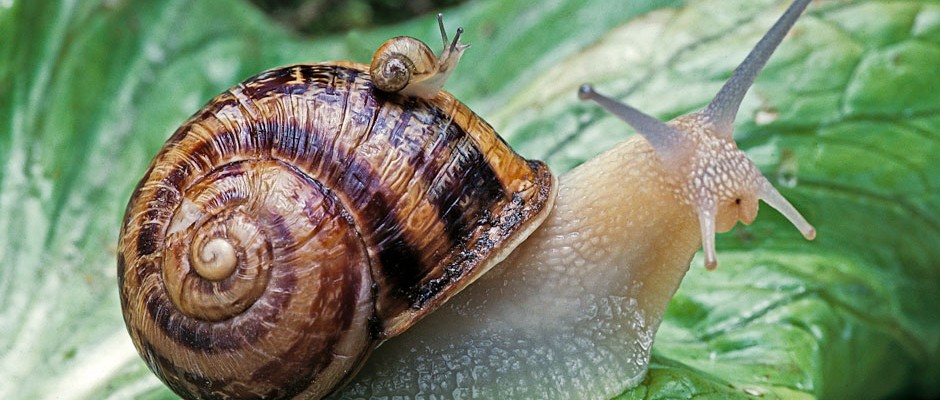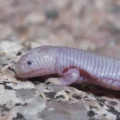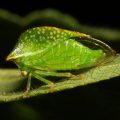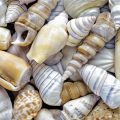Have you ever wondered why snails have such tiny teeth? No, they’re not just cute little decorations – they’re incredibly strong and have the ability to withstand pressure high enough to form diamonds!
Snails are one of the few animals that have teeth. Many species of snail actualy have thousands of microscopic teeth on their tongues, called a radula. These teeth are used for slicing off food and then shredding it as it passes through their tongue. Garden snails typically have around 14,000 teeth while other species can have over 20,000!
These tiny teeth are made from a material that is even stronger than titanium – making them the strongest known biological material on Earth. They can withstand the same amount of pressure it takes to turn carbon into a diamond! As if that isn’t impressive enough, these snail teeth can also be used in medical research as they contain enzymes which act as a natural alternative to antibiotics.
So next time you come across a snail, take a moment to appreciate their small but mighty teeth – they are truly remarkable!

Are Snail Teeth Stronger than Diamonds?
No, snail teeth are not stronger than diamonds. While snail teeth are incredibly strong and tough, they cannot withstand the intense pressure it takes to form diamonds. Diamonds are created when carbon is subjected to immense temperatures and pressures of up to 727 million Pascals (7.27 GPa). On the other hand, the strongest snail teeth have been measured at around 20-30 GPa. Therefore, diamonds are significantly stronger than snail teeth since they can withstand more than twice the amount of pressure of even the strongest snail teeth.
The Unique Characteristics of Snail Teeth
Snail teeth are quite remarkable! Garden snails have about 14,000 tiny, chitinous teeth that are arranged in rows on the radula – a tongue-like organ located in their mouth. These little teeth are incredibly sharp and can easily tear through food like leaves and bark. Not only that, but the teeth of an aquatic snail called the limpet have been found to be the strongest known biological material on Earth – far stronger than titanium! This is due to their unique layered structure which givs them strength and elasticity. Amazingly, these tiny structures can withstand forces up to thousands of times their own body weight!
Do Snails Have Teeth?
No, snails do not have real teeth. Instead, they possess a unique structure called a radula, which is a flexible band of thousands of microscopic teeth-like structures. The radula is used to scrape food particles and can be found in the snail’s mouth. There are different types of radulae depending on the type of snail species; some may have more or feer teeth than others.
The Incredible Number of Teeth Possessed by a Snail
Snails have a band of thousands of microscopic teeth on their tongue called a radula. Each tooth is made up of tiny chitin-based rods arranged in a V-shaped row. These teeth allow the snail to slice off food, which it then shreds as it passes trough its tongue. While snails don’t technically have 14,000 teeth, the hundreds of rows in the radula create an effect that is similar to having many more than that. The rows are so small that they can’t be seen by the naked eye, but together they help snails feed on plants, algae and even carrion.
Do Snail Bites Cause Pain?
No, generally speaking snail bites do not hurt. Most snails have thousands of tiny teeth but their teeth are not large or sharp enogh to cause pain. Instead, most people describe the sensation as similar to a cat’s tongue licking them or a pinch. The only exception is the cone snail, which can give painful and potentially poisonous bites
Do Snails Have 15000 Teeth?
Yes, snails typically have between 10-15,000 teeth. They are organized in rows of about 100 teeth per row, and there may be up to 25 rows. Each ‘tooth’ is a small, conical projection on the radula (think of a shag carpet). This arrangement helps the snail to feed on their diet of algae or othr food sources. On average, most species of snails have around 15,000 teeth. However, some species can have up to 25,000!
What Animal Can Have upp to 25,000 Teeth
The animal with 25,000 teeth is the snail! Snails have a number of rows of tiny teeth located on their tongues that they use to scrape food off surfaces. These teeth are incredibly small, with each being no larger than the head of a pin. Despite their size, snails can have up to 25,000 teeth over the course of their lifetime! Unlike humans and other animals, snails’ teeth are continually lost and replaced like a shark’s; as such, some snails may even have more than 25,000 teeth in total.
The Animal With 14000 Teeth
The garden snail (Helix aspersa) has 14,000 teeth! Unlike other animals, these tiny teeth are located on the snail’s tongue and are made up of rows of microscopic ridges called “radulae”. Each tooth can be used to scrape off bits of food from a surface. Snails use their radulae to graze on algae and other vegetation, making them important members of the ecosystem. As they move over surfaces, they also help to break down organic matter and contribute to soil fertility.
Does a Snail Have 25,000 Teeth?
Yes, a snail does have 25,000 teeth. These are very small, microscopic teeth known as “radula,” which are located on the snail’s tongue. A single radula tooth is made up of thee parts: a base, a shaft, and an edge. The edge of the tooth is covered in thousands of tiny denticles that allow it to scrape food into its mouth. The number of denticles varies depending on the species of snail but can range from around 500 to over 10,000 on a single tooth. Snails use these teeth to feed on algae and other small organisms.
Do Snails Have a Brain?
Yes, snails do have a brain. It is located in the cerebral ganglia and is divided into four sections. This primitive brain is much simpler compared to the brains of mammals, reptiles and birds, but it does allow for some basic functions such as associative learning. The brain of a snail is responsible for controlling their basic body functions such as digestion, respiration, movement and reproduction. It also helps them to find food and avoid predators. Despite its simplicity, the snail’s brain serves an important role in regulating their behavior and allowing them to survive in their environment.
Do Snails Have Blood?
Yes, snails do have blood. Most snails’ blood consists of 20-50% of their body weight, although the sea hare’s (Aplysia) body weight is about 75% blood. The pigment in a snail’s blood is generally haemocyanin, whch is different from the hemoglobin found in mammals. Haemocyanin contains copper instead of iron and is blue when oxygenated, unlike the red hemoglobin found in mammals. This type of blood also helps to regulate a snail’s salt levels, making it more adapted to a marine environment than other species.
Do Snails Produce Waste?
Yes, snails do poop. Their feces is usually small and looks like a string of brown or green matter. However, the exact color can vary depending on their diet. When the snail’s poop dries off it becomes even smaller and darker in color, often appearing as C-shaped black specks.
Conclusion
In conclusion, snail teeth are incredibly impressive. Not only do some species have over 20,000 of them, but the teeth of the limpet are even stronger than titanium! While snails don’t use their teeth to chew their food, these microscopic teeth are able to slice and shred whatever they come across. This strength and versatility make snail teeth some of the most incredible features in the animal kingdom.












